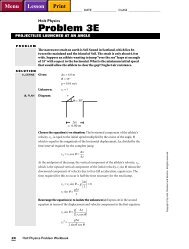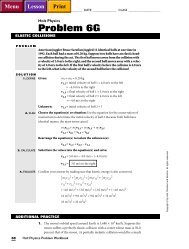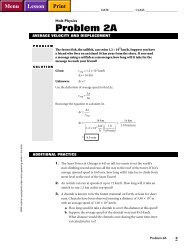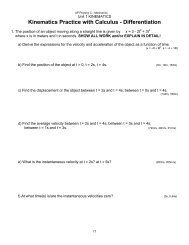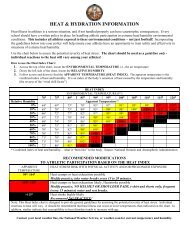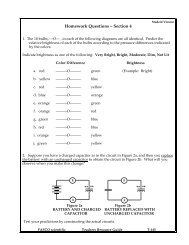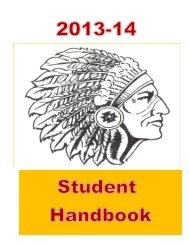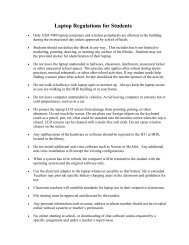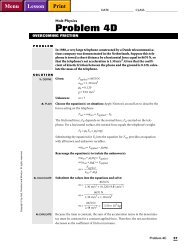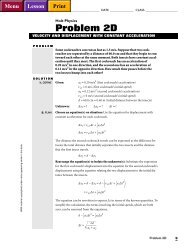Unit 1 Homework - Hays High School
Unit 1 Homework - Hays High School
Unit 1 Homework - Hays High School
You also want an ePaper? Increase the reach of your titles
YUMPU automatically turns print PDFs into web optimized ePapers that Google loves.
<strong>Homework</strong> Questions – Section 1<br />
Student Version<br />
1. In the following circuit, which bulb lights first _______<br />
A<br />
B<br />
[A] Bulb A<br />
[B] Bulb B<br />
[C] Bulb C<br />
[D] They all light at the same time.<br />
[E] Bulbs A and C light first, then bulb B lights<br />
Explain your answer.<br />
C<br />
2. Study the three loops shown below.<br />
For each loop, state which of the bulbs will<br />
light.<br />
A<br />
A<br />
B<br />
B<br />
I. II.<br />
A<br />
B<br />
III.<br />
PASCO scientific Teachers Resource Guide T - 21
3. Study the two circuits below in which a paper clip has been inserted between wires in a<br />
circuit.<br />
Circuit A<br />
Circuit B<br />
Which of the following statements are true _____________<br />
(A) The bulb will light more brightly in Circuit A .<br />
(B) The bulb will light more brightly in Circuit B<br />
(C) The bulb will be the same brightness in either case.<br />
(D) The bulb will not light.<br />
4. Explain why you believe your answer to Question #3 is correct. Use the words<br />
“insulator” and “conductor” correctly as part of your explanation.<br />
5. Write in your own words a definition of the word circuit which anyone could use to<br />
determine if a given set of connections is or is not a circuit.<br />
6. We have observed in several activities that as soon as a very small gap is produced<br />
anywhere in the circuit, the bulbs go out. Would you classify air as a conductor or an<br />
insulator Explain.<br />
PASCO scientific Teachers Resource Guide T - 22
7. Indicate whether each of the following statements is True or False. Then state evidence<br />
which either supports or contradicts each statement.<br />
___ [a] Charge moves out of each end of the battery into the loop.<br />
Evidence:<br />
___ [b] Light bulbs are non-directional devices. (Whichever way they are connected in<br />
the circuit, they behave the same way if you turn them around.)<br />
Evidence:<br />
___ [c] The battery determines the direction of flow of charge in a circuit.<br />
Evidence:<br />
___ [d] A compass can be used to determine the exact direction that charge flows in a<br />
circuit.<br />
Evidence:<br />
___ [e] Metal substances are generally conductors.<br />
Evidence:<br />
8. A group of adventurous students decided<br />
to see if it is possible to light two bulbs at once<br />
without any sockets and using only one battery.<br />
Figure 1 shows a set of connections they<br />
discovered in which both bulbs lit.<br />
a. Draw a line which shows the<br />
continuous conducting path.<br />
Figure 1<br />
PASCO scientific Teachers Resource Guide T - 23
. Figures 2 and 3 show some other possible connections. Decide which, if any,<br />
bulbs will light and draw a line showing the continuous conducting path.<br />
1<br />
1 2<br />
2<br />
Figure 2 Figure 3<br />
Bulb 1: Bulb 1:<br />
Bulb 2: Bulb 2:<br />
PASCO scientific Teachers Resource Guide T - 24




